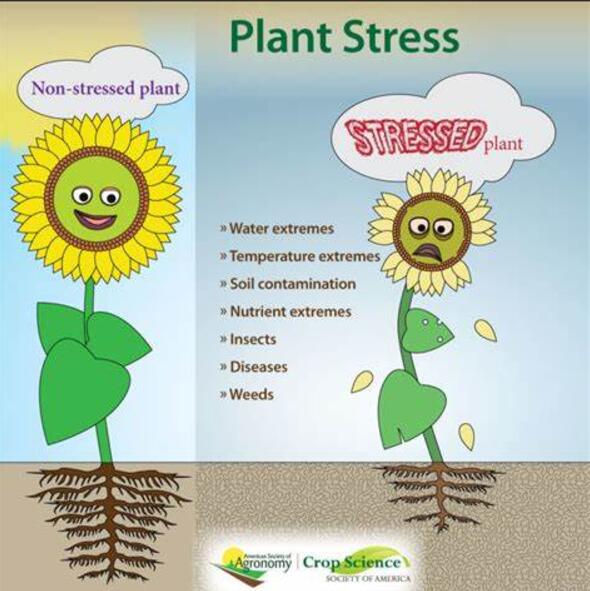Effects of melatonin on ginseng leaf phenotypic and photosynthetic properties following chilling and freezing stress
IF 6.8
Q1 PLANT SCIENCES
引用次数: 0
Abstract
Spring frost damage is a significant natural disaster, which can lead to large-scale ginseng (Panax ginseng C. A. Mey) yield reduction. To determine chilling and freezing stress damage to ginseng, we designed an experiment using three-year-old potted ginseng plants. We simulated chilling (0 ± 0.3 ℃) and freezing (-2.5 ± 0.3 ℃, -5 ± 0.3 ℃) in an artificial room, with 16±2 ℃ of the room temperature at night as the control, to evaluate their physiological effects on ginseng leaf spectral reflectance, photosynthetic characteristics, and chlorophyll fluorescence parameters. We also investigated the mitigating effects of exogenous melatonin on ginseng leaves exposed to chilling and freezing stress. All ginseng leaves died under -5 ℃ freezing stress and the mortality rate reached 25∼57 % under -2.5 ℃ freezing stress, while no plants died under 0 ℃ chilling stress. After -2.5 ℃ and 0 ℃ stress, leaf spectral reflectance in the 750∼1000 nm band was significantly lower than the control; transpiration rate, net photosynthetic rate, intercellular CO2 concentration, and stomatal conductance decreased significantly compared with the control, and there was no significant change in recovery time. The Fv/Fm ratio and qp decreased after low-temperature stress, while NPQ increased. After one week of melatonin application, leaf spectral reflectance in the 600∼650 and 750∼1000 nm bands reflected significant differences between the effects of melatonin application and no application on ginseng leaf chlorophyll content and structure under freezing stress. Ginseng leaf net photosynthetic rate increased by 23.79 % and 4.48 %, while intercellular CO2 concentration increased by 33.49 and 11.83 % under stress at -2.5 °C and 0 °C. The ginseng leaf chlorophyll fluorescence parameter (Fv/Fm) recovered to 0.8 and above in one week after melatonin application, and qp decreased under -2.5 °C and 0 °C stress after melatonin application. Additionally, the NPQ values were 11.44 % and 4.6 % lower in -2.5+MT and 0+MT, respectively, compared to the treatment without MT applied. A sudden drop in temperature to 0 ℃ or even below caused ginseng plant growth inhibition, but melatonin application at a concentration of 100 nmol L−1 had certain mitigating effects on ginseng growth, which provides a theoretical basis and technical support for ginseng production.
褪黑激素对寒冷和冰冻胁迫下人参叶片表型和光合特性的影响
春季冻害是一种严重的自然灾害,可导致人参(Panax ginseng C. A. Mey)大面积减产。为了确定寒冷和冰冻胁迫对人参造成的损害,我们设计了一个使用三年生盆栽人参植株的实验。我们模拟了人工室内的寒冷(0 ± 0.3 ℃)和冰冻(-2.5 ± 0.3 ℃,-5 ± 0.3 ℃),以夜间室温 16±2 ℃为对照,评估它们对人参叶片光谱反射率、光合特性和叶绿素荧光参数的生理影响。我们还研究了外源褪黑激素对人参叶片遭受寒冷和冰冻胁迫的缓解作用。人参叶片在-5 ℃冷冻胁迫下全部死亡,在-2.5 ℃冷冻胁迫下死亡率达到25∼57 %,而在0 ℃冷冻胁迫下没有植株死亡。在-2.5 ℃和0 ℃胁迫后,叶片在750∼1000 nm波段的光谱反射率显著低于对照;蒸腾速率、净光合速率、细胞间CO2浓度和气孔导度与对照相比显著下降,恢复时间无显著变化。低温胁迫后,Fv/Fm 比值和 qp 下降,而 NPQ 上升。施用褪黑素一周后,叶片光谱反射率在600∼650和750∼1000 nm波段上反映出施用褪黑素与不施用褪黑素对人参叶片叶绿素含量和结构的影响有显著差异。在-2.5 °C和0 °C胁迫下,人参叶片净光合速率分别增加了23.79%和4.48%,细胞间CO2浓度分别增加了33.49%和11.83%。施用褪黑激素一周后,人参叶片叶绿素荧光参数(Fv/Fm)恢复到0.8及以上,施用褪黑激素后,在-2.5 °C和0 °C胁迫下,qp下降。此外,与未施用褪黑激素的处理相比,-2.5+MT 和 0+MT 的 NPQ 值分别降低了 11.44 % 和 4.6 %。温度骤降至0 ℃甚至更低会抑制人参植株的生长,但施用浓度为100 nmol L-1的褪黑激素对人参的生长有一定的缓解作用,这为人参生产提供了理论依据和技术支持。
本文章由计算机程序翻译,如有差异,请以英文原文为准。
求助全文
约1分钟内获得全文
求助全文
来源期刊

Plant Stress
PLANT SCIENCES-
CiteScore
5.20
自引率
8.00%
发文量
76
审稿时长
63 days
期刊介绍:
The journal Plant Stress deals with plant (or other photoautotrophs, such as algae, cyanobacteria and lichens) responses to abiotic and biotic stress factors that can result in limited growth and productivity. Such responses can be analyzed and described at a physiological, biochemical and molecular level. Experimental approaches/technologies aiming to improve growth and productivity with a potential for downstream validation under stress conditions will also be considered. Both fundamental and applied research manuscripts are welcome, provided that clear mechanistic hypotheses are made and descriptive approaches are avoided. In addition, high-quality review articles will also be considered, provided they follow a critical approach and stimulate thought for future research avenues.
Plant Stress welcomes high-quality manuscripts related (but not limited) to interactions between plants and:
Lack of water (drought) and excess (flooding),
Salinity stress,
Elevated temperature and/or low temperature (chilling and freezing),
Hypoxia and/or anoxia,
Mineral nutrient excess and/or deficiency,
Heavy metals and/or metalloids,
Plant priming (chemical, biological, physiological, nanomaterial, biostimulant) approaches for improved stress protection,
Viral, phytoplasma, bacterial and fungal plant-pathogen interactions.
The journal welcomes basic and applied research articles, as well as review articles and short communications. All submitted manuscripts will be subject to a thorough peer-reviewing process.
 求助内容:
求助内容: 应助结果提醒方式:
应助结果提醒方式:


